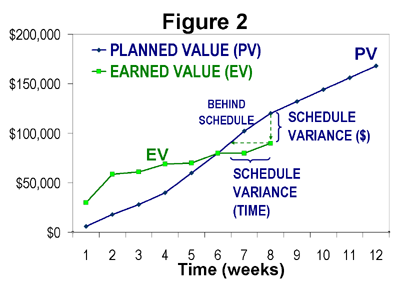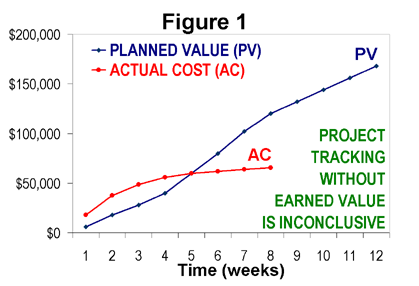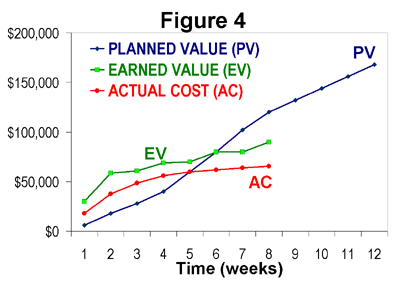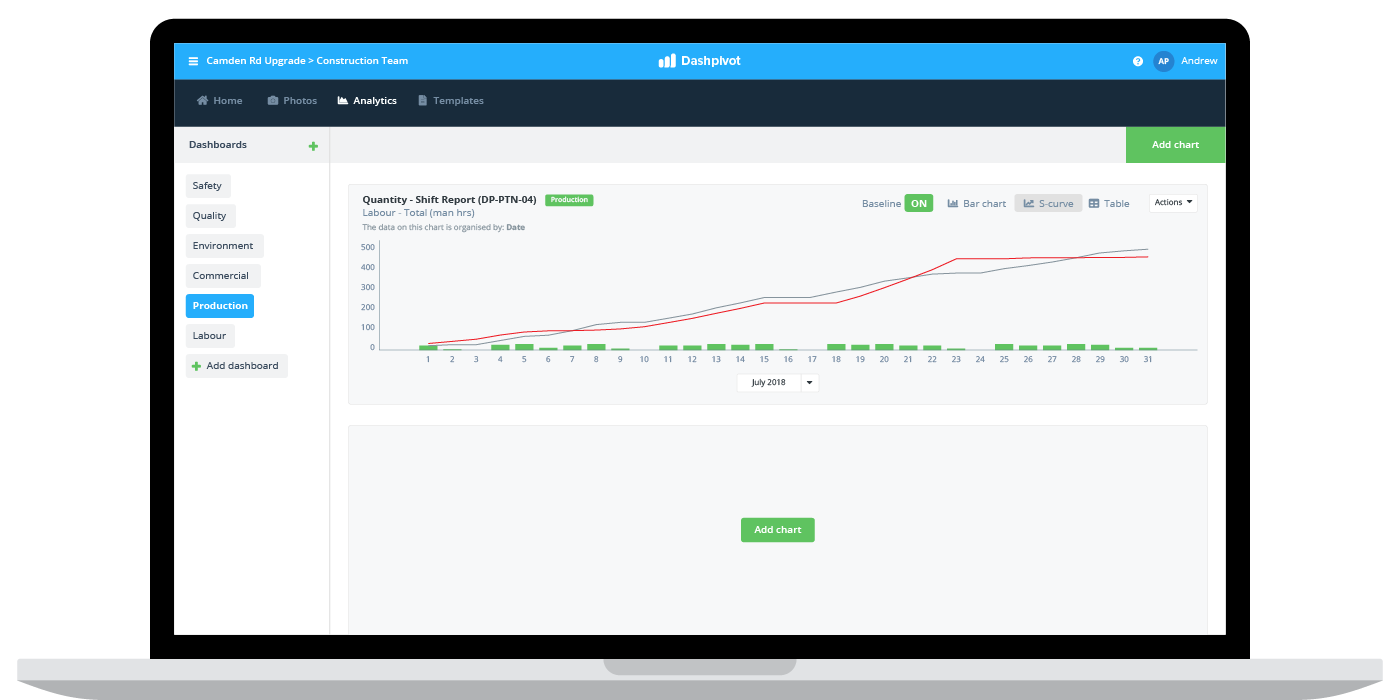Finance – Earned value management

Earned value management (EVM): Everything you need to know
What is earned value management?
Earned value management is a systematic project management technique or process which companies, project managers and other workers use for measuring project performance and progress objectively.
Earned value management is used to find variances in projects based on a comparison between the work which was planned - and the work which has been performed.
The key to earned value management over and above other means of measuring project progress is that it combines all three elements of the project management triangle:
- Scope
- Time or 'schedule'
- Costs
Earned value is combines these elements into a single baseline which can provide the most comprehensive picture of overall project health.
This is incredibly important because understanding scope or progress against time without factoring in costs (or vice versa) isn't an accurate measure of performance.
Earned value management can be used for almost any project, but it is more heavily used in industries including government, education, construction, defence, aerospace and professional services.
Construction is a great example of where and why earned value management is valuable. Construction projects involve the coordination of hundreds of interdependent parties and thousands of moving pieces across long periods of time, as well as external forces outside of a contractor or subcontractors control.
All of these influences can have a powerful impact on project schedules and costs, and earned value management gives companies an objective summary of how the project is tracking from a value perspective.
Earned value vs. planned value and actual cost
There are plenty of topics and elements of earned value which are important, and you can find many of those topics below. Three of the 'value' pillars which you will come across a lot in project management and earned value management are planned value, actual cost and earned value.
Planned value (schedule performance)
Planned value or 'PV' is the first step in earned value management. Much like the name implies, planned value is is simply the approved value or 'cost' of the work to be completed in a given period of time.
The best and easiest way to look at planned value is that you calculate planned value before doing any work or starting the project. This planned value then serves as the baseline for actual cost and earned value.
In terms of its relationship to earned value, planned value is the value that a project should have earned according to the initial schedule - which can then be compared to the earned value at any point in the project.
The other important thing to know about planned value is that the total planned value of a project is known as budget completion - which will be referenced in some of the other helpful articles below.

Actual cost (cost performance)
Actual cost is the 'actual' component of earned value management. Actual cost is the total cost incurred on the project to date - or in simpler terms, the cost or total money spent on the project to date.
Actual cost is not always used in the earned value calculation, but it is used to 'score' earned value by comparing the earned value to the actual cost to date - which will dictate whether the project is performing well, as planned, or poorly.
The weakness of actual cost and planned value without earned value is that the two measurements compared to one another are inconclusive.
As you can see below, by only using planned value and actual cost, we would make the assumption that the project is going great and well under budget But the elements which is missing from this equation is the percentage of the project which has actually been completed.

Earned value (overall performance)
Bringing the above two elements together enables a project manager or company to assess earned value.
Earned value is defined as the value of work which has actually been completed to date. Earned value enables a company to assess the performance of a project today in that it represents the value which would have been created if the project was terminated today.
In the most useful terms, earned value hows a company and management how much value they have earned from the money which has been spent - which is incredibly important to moving forward as a feasible and profitable business.
Earned value is used to measure project performance against the schedule or 'time as well as against cost.
In the illustration below, you will see this.
In contrast to the previous EVM graph, when you see that the earned value of the project is 'behind' or beneath the planned value do we realise that the project is below budget - but also behind schedule in terms of work completed.
By using this more accurate graph, we can see the project is under budget, but also behind schedule.

The benefits of earned value management...
The detail and accuracy of earned value management as well as its quantitative nature make it incredibly valuable for early and mid-project forecasting. Management teams use EVM to get early and important visibility into the current and future time and cost-related issues associated with their projects which enables better current and future decision making to keep projects on track - or get them on track quickly.
EVM insights can mitigate many of the risks associated with running projects (especially running them blind) including scope creep, and time and budget overruns. In fact, good and accurate earned value management can prevent many of the end of project headaches experienced on almost all projects.
The main benefit of earned value is similar to the benefit of calculating profit over revenue and costs. Looking at revenue alone is a relatively poor indicator of business success (although it does show progress of some sort), while looking at costs alone isn't a good predictor of success either.
You need to look at profit in order to understand whether a company or business is healthy, and whether it's inputs are resulting in greater or profitable outputs.
Lastly and equally importantly, earned value management forces a project, workers and managers to be accountable for performance as the project progresses. EVM raises a mirror to the work which has been completed to date, so that all stakeholders must be honest about performance and make the necessary adjustments.
Helpful topics and resources for EVM understanding
Earned value management is a big and meaty subject, even for the most seasoned project manager or project campaigner. In order to best understand earned value management, or dive into the details which you care most about, we have assembled some of the key topics associated with EVM below.
Some of them can serve as important supplemental materials to this article and other resources, while some standalone as key references.
If you are more interested in calculating and 'using' earned value management from a numbers of formulas perspective, we have more detail about that below as well.
| Topic | What it's about |
|---|---|
| Earned value management example | See an example of earned value management in action, including how it can be used and calculated on an actual project like yours. |
| Earned value analysis example | See an example of how earned value can and should be analysed properly. |
| Earned value management for dummies | A back-to-basics read about what earned value management is and isn't. |
| SV project management | SV or 'schedule variance' is one of the most important components of EVM. Read more about it here. |
| EAC in project management | EAC or 'estimate at completion' is the forecasted cost of a project as it progresses. Read more about EAC here. |
| Construction S-curve | The S-curve is a powerful construction and project management graphical report. Read more about it here. |
| S-curve example | See an example of an S-curve graph and how it's interpreded and used. |
| Construction cash flow forecast | Understanding progress is important, and so is understanding whether there is enough cash to complete the project. |
| Construction cash flow | How is cash flow related to EVM on construction projects? |
| S-curve graph | Learn more about the S-curve graph and how you can use it. |
| Cost variance (CV) | Project success is based largely on the performance against the budget, because that impacts our profits. Cost variance is one of the most powerful tools in staying on budget. |
| Cost performance index | Learn more about cost performance index, and how crucial it is to your project cost efficiency. |
| Budgeted cost of work performed (BCWP) | Learn more about BCWP, and whether it's different to EV or not. |
| Budgeted cost of work scheduled (BCWS) | Better understand BCWS to keep your projects on schedule more often. |
| Variance at completion (VAC) | Make more accurate projections and smarter decisions about your project costs. |
About calculating earned value management...
Earned value management is a very quantitative measure, which is what we need in an objective metric. The problem with many types of project tracking and status updates given by managers or leaders is that they are inherently skewed and often bias.
It's basically impossible for humans to overcome the planning fallacy, and for them to be comfortable disappointing stakeholders and clients by telling them things are behind schedule or over budget.
All of these things combine to push key people to stretch the truth or exaggerate how well the project is going - even if unintentionally.
Earned value management is a great way to overcome these biases and give an objective and unbiased gauge on project performance.
There are a bunch of great resources and links to articles about specific elements of earned value management formulas and calculations below. Use the resources and information which is most applicable to you.
| Earned value management formulas and tools | About |
|---|---|
| Earned value calculator | Proper EVM calculations. |
| Earned value management formulas | All of the EVM formulas you need to know. |
| Budget at completion | Important formulas and calculations around the all-important budget at completion. |
| Earned value calculation excel | How to use excel for earned value calculations, and why you maybe shouldn't. |
| Earned value formula | The simple and comprehensive earned value formula. |
| Project cost management | Project cost management is critical to project success, here's how formulas can help. |
| Earned value calculation | All about calculating earned value. |
| EVM metrics | The metrics you need to measure and care about when it comes to EVM. |
| Earned value formula sheet | A reference sheet for all of your earned value management formulas. |
| S-curve formula | Important formulas for the S-curves. |
| How is earned value calculated? | An article about how EVM is calculated, along with some helpful examples. |
| Cost variance formula | Keeping your projects on budget is critical and tricky - and one of the best tools you have is cost variance. |
| Estimate at completion formula | See the different formulas for calculating estimate at completion. |
| TCPI formula | Understand how to get your projects back on budget or keep them on budget with TCPI. |
| Cost performance index formula | Understand your project financial effeciency before it's too late to get things back on track. |
Systems for improving how you manage and track earned value management
Speaking about earned value management is of course the easy part of things, as is the case with all project management theories and techniques. In theory, the benefits of the process are clear and everyone should use earned value management, but there are of course plenty of things which make EVM difficult in practice.
In order to get around some of the difficulties associated with earned value management, companies and project managers assemble earned value management systems and take advantage of earned value management softwares.
These tools, as well as tools dedicated to other aspects of the earned value management sphere enable companies to track and calculate earned value management more accurately, and more efficiently.
Earned value management system
An earned value management system is similar to quality and safety systems, which most companies (especially construction and industrial companies) are very used to.
An earned value management system is a collection of tools, templates, processes and procedures that the organisation uses to 'do' EVM.
Systems can vary quite widely from company to company, as the most efficient system depends on the type of work being conducted as well as the resources available for this type of analysis.
Developing a reliable earned value management system is one of the first steps to establishing a consistent approach to earned value management as a project management technique.
Earned value management software
The rise of project management softwares and other software tools has been a game-changer for managing projects for every type of company. Today, there are dedicated softwares or full packages which enable companies to build a software-based earned value management system.
A system created through software is similar in many ways to a traditional system in that there is still a set of tools, templates and processes. The difference is that all of these components live inside of a software system which pulls them together automatically and moves and crunches data automatically.
S-curve reporting tools and software
The S-curve is another important tool in the arsenal of project managers, and one which is closely coupled to earned value management.
Some softwares combine these S-curve reporting tools and softwares into a single package, while others separate and specialise in these different components of project management tracking.

Manage EVM more efficiently by trying this software for free.
Earned value management templates
Not all construction or project-based companies have streamlined earned value management processes, and many companies only run into project projection and tracking issues as their companies and operations become larger and riskier.
For this reason, many companies looking to begin tracking projects more objectively and effectively begin by looking into earned value management and seeking out best practices - often in the form of templates.
There are a number of helpful EVM templates available online, as well as individual templates for calculating and building specific aspects of the earned value management equation.
The principles of earned value management are very strong and applicable across every type of project management, so you can adopt and integrate some of these templates into your operations.
The main thing to look for when assessing and adopting these templates is whether or not they fit and align with the way that you do work.
There are two main features of good earned value management:
- Accuracy
- Efficiency
You won't your EVM numbers and calculations to be as accurate as possible, but not to the detriment of actual project progress.
Finding the balance between tracking earned value management accurately and not 'wasting' time and resources on staying on top of progress and percentages is important.
Understanding progress is incredibly important, but making progress is more important.
The downsides of earned value management
We've covered many of the positive aspects and strengths of earned value management in this article, as well as given you many of the resources and tools you will need to adopt EVM and make it a powerful addition to the way you manage projects.
But like all aspects of project management and most aspects of life, there are some downsides and things to be wary of when tracking, explaining and relying on earned value management.
EVM doesn't ensure quality or safety
Earned value management is extremely helpful for calculating and understanding raw progress from a production and financial standpoint.
But what it doesn't do is speak to or illustrate the quality of the project, the safety of operations, and whether other parties and stakeholders are happy.
These other aspects of a project are critical to the success of the project as well as the reputation of a company, so you must be careful to not to become too focused on the limited dimensionality of EVM.
If a project is delivered on time and on budget, but fails to meet the required quality standards, then the project clearly wasn't successful - even if EVM says so.
Your EVM must be accurate and timely
Earned value management is only as good and as useful as the accuracy and timeliness of the data being collected. If the data being collected and reconciled from site isn't good and accurate data, then project managers and management will be making projections and decisions based on the wrong information.
Having the wrong data during the course of a project can be more toxic and problematic than relying on an initial plan.
Earned value management needs context and communication
Earned value management comes with great promise and application for project managers and project management companies - but just like all other business metrics, EVM requires additional context and information.
Delivering EVM numbers and reports to customers and stakeholders can be valuable, but it doesn't and can't tell the full story.
Whoever is conducting and reporting on EVM needs to pull other functional managers or facets of the business into the reporting circle or have a deep understanding of the entire project.
Getting started with earned value management
Earned value management is no different to any other project management technique in that it can't tell the full story; but, it is one of the most 'valuable' and objective measures and tools available to any company and any project.
Earned value management is a must for companies managing projects with any complexity, risk and sustained period of time. It is one of the most powerful tools for project planning, costing, and project management.
I hope you got some value out of reading this information on earned value management, and can explore some of the additional EVM resources and article available above.
If you have any questions about earned value management or see a specific EVM topic which is missing from this intended comprehensive article - then drop us a comment below.